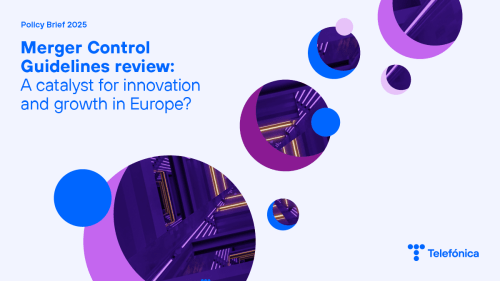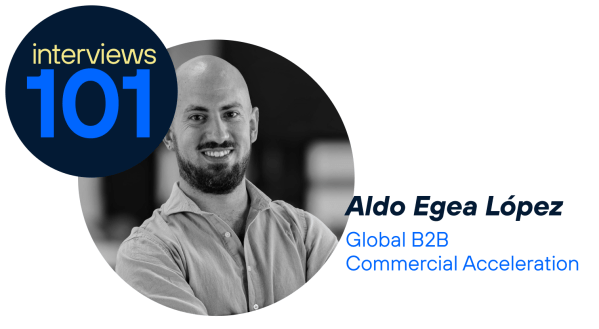Tell us a little about yourself. What does your job at Telefónica involve?
I am currently the manager of Digital Transformation Acceleration and Innovation Ecosystems (Wayra and OpenFuture) at Telefónica, and the truth is that I wear several ‘hats’, all of them equally interesting.
On the one hand, I lead a team of consultants who accompany large companies in their digitalisation roadmap, helping them to transform their business models.
On the other hand, I am responsible for the team in charge of identifying and connecting Wayra and OpenFuture start-ups to expand our portfolio of solutions and boost their commercialisation.
And last but not least, I coordinate the #LaCabina team, our showcase of innovation and talent at Telefónica, a living space where we demonstrate the value of technology through talks, workshops and demonstrations. I also lead the communications team with the challenge of making innovation understood and shared.
What is the relationship between digital transformation and innovation ecosystems?
Transforming an organisation requires much more than just applying technology: it means diagnosing the starting point, defining clear objectives, establishing the milestones that will mark the path towards the goal.
To achieve this, it is essential to have experienced strategic allies, to foster a spirit of co-creation and collaborative ideation, and this is precisely where innovation ecosystems come into play.
At Telefónica, our innovation ecosystems such as Wayra and Openfuture allow us to create hubs and open innovation and entrepreneurship platforms with a global presence and connection in Europe and Latin America. They are set up as a collaborative network of companies, start-ups, institutions, universities and R&D centres where knowledge can be shared, pilot projects developed, solutions scaled up and technological adoption accelerated.
We have methodologies designed to experiment quickly and learn from mistakes, capable of reinforcing any idea or project, creating lines of business, giving visibility and internationalising technological solutions in all sectors of activity.
The ecosystem is a living entity, even more so now with the application of AI, and innovation projects are committed to the development of new technologies as a transformative core.
In our case, innovation and creativity are based on the search for solutions with a business vision, combining technologies such as 5G, Network Slicing, Edge Computing, BigData, IoT, Cybersecurity, etc.
According to McKinsey, companies that collaborate in ecosystems are 2.1 times more likely to outperform their competitors in innovation and digitisation indicators.
What is clear is that digital transformation is not an option, it is an obligation to survive, ‘go digital or die’ even if it sounds strong.
What changes should companies undertake for digital transformation?
It all depends on the starting point, but it must be approached in an orderly and prioritised manner. There is no point in digitising only part of the organisation. The area of people, processes and operations, the lines of business and supply, … that is to say the front office and the back office must advance in parallel.
One of the great challenges is to break down the silos. A well-planned ‘digital workplace’, with a collaborative culture, allows teams to align and work in the same boat. There are no shortcuts, it is a cultural and technological path that requires commitment:
- Changing the company culture.
- Lead with a digital mindset, prioritising collaboration.
- Invest in training and capacity building for teams in new digital skills.
- Review internal processes, redesigning with a focus on data, efficiency and customer experience.
- Create architectures where data is key, to capture and analyse data in real time.
The pandemic was a clear accelerator; many companies reinvented the way they work. Now, with the rise of AI, we are once again under scrutiny. Only companies that have digitised their processes will be prepared to integrate AI effectively.
The key is to identify everything that can be done in terms of processes, people and technology, analyse each project to see how they align with the organisation’s strategy, the cost of implementing it and the business KPIs that would improve with its implementation.
With that you have enough information to prioritise them, choose which ones will be part of the quick win, make a master plan or roadmap and organise a digital transformation office to organise and monitor execution in parallel with a change management project.
What exactly does this concept consist of?
I mean that companies that are more digitised, that is to say those that already have cloud computing, mobile applications, structured databases, digital security, digital employees, etc., are better positioned to make the leap towards automation using automation tools and artificial intelligence technologies. Those that have not yet taken these steps must build a solid technological and operational foundation.
What are the keys to digital transformation?
I have already mentioned many of them. In short, it is about digitising first and then automating with AI.
Mainly having clear leadership committed to the digitalisation of processes-people-businesses, investing in an adaptive and collaborative culture, promoting the training of digital talent, orienting all departments towards data to anticipate, personalise and make better decisions, and investing in technology as an enabler of change to become competitive, efficient and improve the customer experience.
What future can await organisations that are late to the digital transformation party?
It’s never too late, but the sooner you start the better. The important thing is to take the first step with a good strategic ally, with experience and global vision like Telefónica.
That said, organisations that don’t prioritise digital transformation run the risk of being left behind.
Who do you nominate from among the people who work at Telefónica for this interview that you consider to be excellent in their work?
I nominate Juan Félix Beteta.








